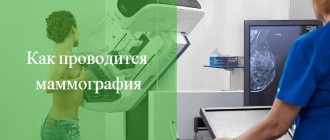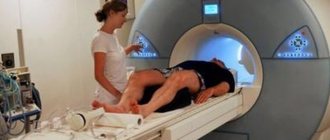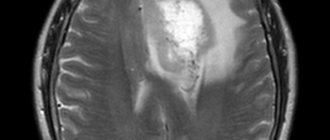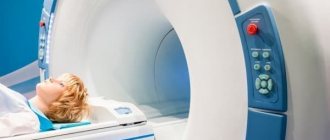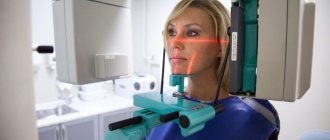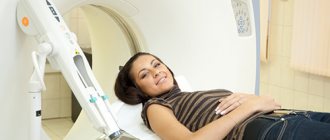If the doctor has prescribed an MRI for your baby, there is no reason to worry, the procedure is harmless in the absence of contraindications
Magnetic resonance imaging is a highly informative study that allows you to obtain layer-by-layer images of any area of the body. Parents have questions about at what age children can have an MRI and whether there are risks, what the doctor will see in the images.

In pediatric practice, magnetic resonance scanning is prescribed upon reaching the age of one month. The study is absolutely safe and does not imply any harmful effects of X-rays on the body.
Magnetic resonance scanning has a number of advantages compared to other diagnostic methods:
- high spatial and contrast resolution of images;
- non-invasiveness (MR imaging does not require the penetration of instruments into the patient’s body, with the exception of intravenous injection of dye according to strict indications);
- painlessness;
- the ability to assess the morphology and function of organs;
- more accurate demonstration of changes in soft tissues.
Do children get MRIs of the brain ? The study is widely used as a tool for visualizing congenital anomalies of the central nervous system, tumors, post-traumatic injuries (including the consequences of difficult childbirth), cystic formations, ischemia, inflammatory and infectious processes, etc. Scans allow assessing the disturbance of the macrostructure of the brain, differentiating between healthy and altered tissues , detect areas of increased/decreased density, fluid accumulation (edema, hydrocephalus). The results of the study help to choose treatment tactics.
An MRI of the child’s brain is prescribed by a pediatric neurologist, oncologist, neurosurgeon and other specialists. Diagnostics can be done under the compulsory medical insurance policy. To do this, you need a special form of referral from the attending physician and a commission conclusion.
At what age do children have MRIs? Magnetic resonance scanning is routinely performed on infants starting at 4 weeks of age.
How is MRI performed on children?
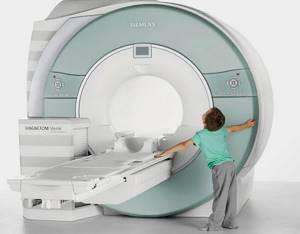
To encourage your child to nap during the procedure, put him to bed two hours later and wake him up an hour earlier.
With some time left, the baby and accompanying adult (parent, guardian) arrive at the clinic. Before the procedure, the medical staff prepares documents (outpatient card, consent for diagnosis), and identifies possible contraindications. Inform in advance about installed vascular stents, functioning devices (device for drug delivery, auditory prosthesis, neuro-, myo-, pacemaker, etc.), orthopedic structures. The above are considered contraindications to exposure to a magnetic field.
The X-ray technician places the baby on the tomograph table and explains the rules of behavior. For moral support, a parent can be present in the diagnostic room; clothing should be free of metal parts.
At the operator’s command, the table moves the small patient into the tunnel of the unit. The device produces technical noise during operation; for comfort during the procedure, headphones are used. The medical staff watches the progress of the scan through a window from the adjacent room.
For infants and young children, native and contrast magnetic resonance scanning is performed in a hospital setting.
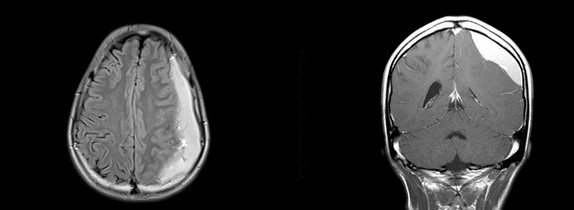
Hematoma on an MRI scan of the brain
Main indications for MRI in children:
- Convulsions, fainting, developmental delays, progressive deterioration of hearing, vision, speech disorders, ambiguous neurosonography data, unexplained cephalgia, cerebral palsy (cerebral palsy), injuries, etc. MRI of the child’s brain shows congenital malformations, hypoxic-ischemic and hemorrhagic lesions of the central nervous system, changes characteristic of intracranial infections, hematomas, etc.
- Excessive regurgitation, blood in the vomit, stool abnormalities, bloating, cough caused by food entering the trachea, etc. Visualization by ultrasound of changes suspicious for abnormalities in the development of the gastrointestinal tract is an indication for MRI in a child in the first weeks of life.
- The baby’s restlessness when urinating, fever, refusal to eat, lethargy along with changes in urine tests (protein, leukocytes, red blood cells, bacteria, salts), visualization on sonograms of hydronephrotic transformation of the kidneys, accessory vessels, etc. MRI is performed on the child to determine management tactics , as part of preoperative diagnosis.
The study is used when a tumor of any location is suspected, to detect metastasis, evaluate the effectiveness of therapy, etc.
Indications for MRI and X-rays
The applications of MRI are varied. This research option gives better results when examining soft tissues, so the procedure is prescribed for:
- detection of cancer;
- identifying a hernia;
- the presence of developmental anomalies, injuries or pathologies of the spinal cord;
- the course of inflammatory processes;
- identifying foci of infection and the need to assess their intensity;
- the presence of pathological zones in soft tissues.
As for x-rays, specialists resort to its help when:
- joint dislocations;
- broken or cracked bones;
- the presence of diseases of the musculoskeletal system;
- the need to check the body for the presence of foreign bodies.
Get a free consultation Consultation on the service does not oblige you to anything
In some cases, infectious, inflammatory or pathological processes affect not only soft but also hard tissues. In such situations, simultaneous MRI and X-ray are prescribed. The resulting images will allow you to get the most complete picture of the state of a certain area.
Prices for MRI in Moscow may vary. The cost of the procedure will depend on the general pricing policy of the medical center, as well as on the area requiring examination.
The cost of an X-ray will be lower than an MRI. The price of this procedure will depend on the volume of the area being examined, since the main influence on the price indicator will be the format of the film used.
Is it possible to do an MRI with contrast for a child?
Enhanced MRI: benign cyst at the cerebellopontine angle (arrow)
Chelated gadolinium paramagnetic improves imaging capabilities. Children's age is a relative limitation to contrast: if there is a threat to life, the decision to perform an enhanced MRI is made by a council of doctors. Gadolinium allows you to get an idea of the tumors (borders, exact localization, distant metastasis, the presumable nature of the tumor - benign, malignant, growth prospects), features of the blood supply to organs (ischemia, stenosis, vascular malformations, aneurysms, etc.). The dye accumulates in the affected tissues, making the images as clear as possible. General contraindications to the administration of a contrast agent are:
- renal failure with a decrease in glomerular filtration rate less than 30 ml/min;
- polyvalent allergies, including gadolinium intolerance.
For ethical reasons, studies examining the side effects of paramagnetic administration to children have not been conducted. Preparations containing gadolinium are not recommended for use in children under two years of age due to insufficient safety data.
Contraindications for carrying out
Regardless of how an MRI is done and what organs are to be examined, there are a number of situations in which the procedure is strictly prohibited for children. These include the presence of internal ferromagnetic structures and the inability to remain stationary during the entire duration of the study. MRI should not be performed on children who are allergic to components of anesthesia drugs (if the procedure is planned to be carried out in an unconscious state). Claustrophobia and the already mentioned epilepsy are also contraindications. In these cases, it is advisable to think about performing an MRI on the child under general anesthesia. A way out of the situation may be to use an open-type tomograph.
MRI under anesthesia for a child
There are a number of situations in which it is not possible to perform an MRI on a child without sedation or general anesthesia. Indications for anesthesia include: children under one year of age, the presence of mental disorders, hyperactivity, and a tendency to epilepsy. If the institution you choose does not have an open-type tomograph, and the baby suffers from claustrophobia, then he will also be rendered unconscious. Should we expect any negative consequences if a child is given anesthesia during an MRI? Practice shows that complications occur in less than 1-2% of patients. For the vast majority, the procedure is asymptomatic. Within half an hour the child will be ready to eat and return to his normal lifestyle.
How to prepare your baby?
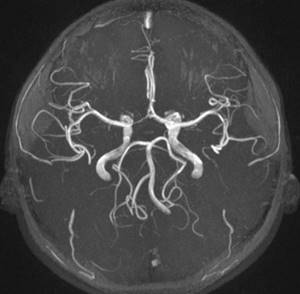
Magnetic resonance imaging with contrast shows normal cerebral arteries in a child
The success of the diagnostic procedure largely depends on the actions of the parents. An MRI is performed on a small child under sedation. Immersion in anesthesia implies a 4-6 hour fast. Native scanning of the brain and spinal cord, examination of the osteoarticular apparatus does not require preparation. If an assessment of the abdominal organs and retroperitoneal space is planned, foods that contribute to bloating are excluded from the diet 2-3 days before:
- cabbage in any form, corn (popcorn), peas, beans;
- raw vegetables, fruits, berries;
- confectionery, cocoa, chocolate, baked goods, etc.;
- black bread;
- nuts, seeds;
- cream, full-fat sour cream;
- carbonated drinks, freshly squeezed juices with pulp, etc.
How to prepare your child for an MRI with contrast:
The last meal is allowed 4-6 hours before diagnosis, the baby is fed 3 hours before. The day before and after contrasting, it is recommended to drink more fluid: this reduces the likelihood of complications and promotes faster removal of the paramagnetic from the body. To prevent reactions from the autonomic nervous system, a light snack is allowed 20 minutes before leaving the house.
Useful tips for parents:
- Explain to a child over 5 years old the essence of the upcoming event in easy-to-understand words; you can “examine” a doll or bear in the form of a game in advance, or show a thematic video.
- Warn that the device makes sounds during operation, but there is no need to be afraid of noise, emphasize that there is no pain.
- On the eve of diagnosis, protect your child from physical exertion and emotional overstimulation.
- Ensure full nasal breathing: if you have a runny nose, it is better to postpone the procedure or, on the recommendation of a doctor, use special means.
- Choose clothes made from natural fabrics without metal parts.
- Take with you a change of diaper, sanitary napkins, and don’t forget your documents - birth certificate, insurance policy, your passport, hospital extracts, results of previous diagnostics.
When is anesthesia needed?

The anesthesiologist will monitor the baby's condition during medicated sleep
Where and how (with or without sedation) to get an MRI for a child depends on the patient’s age and clinical situation. To obtain high-quality images, maximum immobility for 15-30 minutes is important. A child over 5 years old is able to lie quietly during the diagnostic procedure and follow the commands of the medical staff. For infants and young children, anesthesia is required. The examination under sedation is performed in specialized centers in the presence of an anesthesiologist. Indications for medicated sleep:
- hyperactivity syndrome;
- age up to 5 years;
- epilepsy (risk of developing a seizure);
- claustrophobia;
- severe pain syndrome;
- some mental illnesses (schizophrenia, Down's disease, dementia, etc.).
The dose and type of sedation will depend on the child's condition and age at the time of the MRI.
Is anesthesia during MRI harmful for a child?
To perform an MRI on children (and some adults), sedation rather than anesthesia is used. This is a short-term medicated sleep, which is used, for example, to painlessly remove a tampon from the nose after surgery. For sedation, the anesthesiologist individually selects the composition (often using several components), taking into account the weight and diagnoses of the small patient. The drug is injected into an intravenous catheter. Most children immediately get up after an MRI and behave in the same way as after waking up in the morning. Anesthesia has no effect on the body.
At what age can you get tested?
Magnetic resonance imaging is performed on children starting at one month of age. If a baby with pathologies is born prematurely or receives a birth injury, the study can be performed earlier.
MRI is used to evaluate intrauterine malformations in the fetus, and sometimes scan results serve as an indication for surgery during pregnancy. Magnetic resonance imaging with contrast is available according to indications from 2 years of age.
How often can children have an MRI?

The doctor decides how often to diagnose the baby.
A native (non-contrast) study can be performed on a patient over 5 years of age an unlimited number of times - as required by the medical situation. Enhanced MR scanning is used in oncology practice as the main diagnostic tool for identifying early tumor relapse and assessing the effectiveness of treatment. The optimal interval between MRIs is 6 months.
For young patients for whom it is impossible to perform a magnetic resonance examination without anesthesia, it is preferable to choose ultrasound, neurosonography, etc. for dynamic monitoring.
Is it safe?
At the beginning of the use of MRI diagnostics in medicine, due to a lack of information, the study was prescribed for health reasons. More than thirty years of experience in the use of magnetic resonance scans has shown that there is no danger to a growing organism: under the influence of the field induced by the device, no biochemical reactions occur, there is no effect on the immune, reproductive systems, brain functions, etc.
There are certain risks associated with anesthesia to ensure the baby's medicated sleep, so electrocardiography (ECG) is first performed, test results and general condition are assessed. During the procedure, the doctor monitors pulse, blood pressure, oxygen saturation and other vital signs.
At the Magnit Center in St. Petersburg, a child over 5 years old will be tested on a doctor’s referral or upon self-referral. It is possible to undergo an MRI of any area of the body at night; discounts will be a pleasant bonus. Diagnostics are carried out using an expert-class Siemens scanner with a field strength of 1.5 Tesla. You can sign up in person, through the contact form on the website or by phone. Late diagnosis of a serious pathological process in a child is life-threatening. Come - we are waiting for you!
How to prepare for the procedure?
Another question that worries parents is: “How to prepare a child, especially a preschooler, for an MRI of the brain and other parts of the body?” First of all, you should stop eating before the procedure. For infants - at least a couple of hours; for older babies, the period increases to 4-5 hours. Why is it important? The fact is that anxiety - and it is inevitable - in some cases provokes vomiting. If an MRI is planned under anesthesia, the child should not eat since the evening of the previous day. Parents should also pay attention to the clothes they dress their child in. The presence of metal parts (rivets or zippers, etc.) is not allowed. If a child wears earrings or a cross, they also need to be removed.
